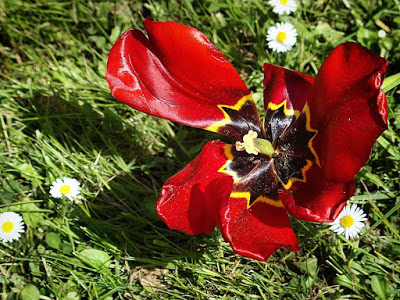by Baxter
 |
| Red Tulip by Marie Lossky (@Marie.Lossky on Instagram) |
In her recent post Yoga for Arthritis: The Big Picture, Nina described the three types of arthritis: osteoarthritis, rheumatoid arthritis, and menopausal arthritis. Although we have written fairly extensively about osteoarthritis in the past, it turns out we have never directly addressed how yoga can be helpful for working with rheumatoid arthritis (RA). So today, I will remedy that!
I’ll start by describing what this condition is, provide some background on the scientific research on yoga and rheumatoid arthritis, and conclude with my recommendations for practicing yoga for rheumatoid arthritis.
What is Rheumatoid Arthritis?
Rheumatoid arthritis is an autoimmune condition in which your body mistakes the lining of your joints (the synovial membrane) as a foreign invader and attacks it as it would a virus or bacteria. This attack creates inflammation inside the joint spaces, which over time ultimately destroys the synovial lining, then the underlying cartilage, and finally the bone, resulting in breakdown and deformity of the joints. This destructive process also affects the structures around the joints, weakening the joint capsules, ligaments, muscles, and tendons, which further contributes to poor function, instability, stiffness, and pain. Rheumatoid arthritis usually starts by affecting joints in the hands and feet, but over time can involve all the major joints of the arms and legs. It accounts for about 10% of all arthritis cases.
Although it is still not clear what triggers the autoimmune response, it is believed genetics plays a role, and it may be that environmental factors (such as exposure to asbestos) and infections are also be triggers. You are at higher risk of developing rheumatoid arthritis if you have a first degree relative with it, if you are a woman, smoker, or are overweight. Unlike osteoarthritis, which becomes progressively more common with age, this condition usually arises between the ages of 40-60. About 40% of those with rheumatoid arthritis will also experience negative effects to other body systems, such as the heart, lungs, eyes, and skin (psoriasis).
The course of the condition is variable, with periods of flaring of symptoms alternating with periods of relative remission. The most common symptoms include joint swelling and tenderness over the joints, stiffness around affected joints, and during flares fatigue, weight loss, and possibly fever.
Western treatment aims at reducing the inflammation if possible, with powerful medications (such as steroids, anti-cancer medications such as methotrexate, and even gold!), and treating symptoms of pain, stiffness, and fatigue with a variety of other medications as well. Physical therapy to maintain joint range of motion and to keep the muscles strong is also often prescribed.
Research on Yoga for Rheumatoid Arthritis
There has been a decent amount of research on yoga and rheumatoid arthritis, with 21 studies cited in the recent text Principles and Practice of Yoga in Health Care by Khalsa, et al. From their review of those studies, the authors of this book recommend that yoga be considered as an adjunct to western treatments (as opposed to a primary form of treatment), and noted that it had the best benefits on improving physical function and activity, addressing quality of life issues, symptom relief, and sleep quality (pg. 169). (By the way, in 2015 Nina discussed in detail one of the studies cited in the book in her post Yoga Helps Both Rheumatoid and Osteoarthritis).
Yoga for Rheumatoid Arthritis
In general, the recommendations we have made for working with osteoarthritis also apply to rheumatoid arthritis (see Yoga for Arthritis: The Big Picture). These include practicing both active and gentle asana sequences to build and maintain strength and flexibility, as well as using stress management tools and equanimity practices to help with pain and stress.
However, when a yoga practitioner with rheumatoid arthritis has a flare, a regular active asana class or practice could worsen symptoms. So, for those times, you should temporarily replace your active asana practice with gentle and restorative practices. Avoid bearing weight on the affected joints. For pain and stress, shift toward towards calming breath practices, such as lengthening the exhalation and alternate nostril breath (see Calming Breath Practices We Recommend and Breath Practices for Balance), and meditation. For more information on yoga for pain management, see Yoga for Pain Management: The Big Picture. Once the flare has calmed, gradually return to a more active physical practice.
For those of our readers who are living with rheumatoid arthritis, we’d love to hear what is working for you.
Follow Yoga for Healthy Aging on Facebook ° To order Yoga for Healthy Aging: A Guide to Lifelong Well-Being, go to Amazon, Shambhala, Indie Bound or your local bookstore.


Leave A Comment